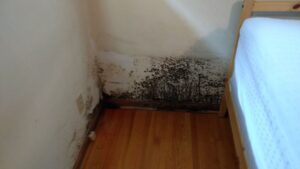
Mold is a common problem that can occur in homes, offices, and other indoor spaces. It can grow in damp and humid environments, such as bathrooms, basements, and kitchens, and can be found in various colors, including black, green, white, and gray. While mold plays an important role in nature by breaking down organic matter, it can pose health risks when it grows indoors and is inhaled or comes into contact with the skin.
Symptoms of Mold Exposure
Mold can release spores into the air, which can be inhaled by occupants of the indoor space. These spores can trigger allergic reactions and other health issues in some people. The symptoms of mold exposure can vary depending on the individual’s sensitivity to mold, the duration of exposure, and the type of mold present. Here are some common symptoms of mold exposure in Little Rock AR:
- Respiratory Issues: Mold spores in the air can irritate the respiratory system and trigger various respiratory issues, such as coughing, sneezing, wheezing, and shortness of breath. People with pre-existing respiratory conditions, such as asthma, may experience worsening of their symptoms when exposed to mold.
- Allergic Reactions: Mold is a known allergen and can cause allergic reactions in some individuals. Common allergic reactions to mold exposure may include nasal congestion, runny or stuffy nose, itchy or watery eyes, skin rash, and throat irritation.
- Fatigue and Headaches: Prolonged exposure to mold can also result in symptoms such as fatigue, headaches, and difficulty concentrating. These symptoms may be persistent and can affect the quality of life of those exposed to mold.
- Skin Irritation: Mold can irritate the skin, especially if there is direct contact with moldy surfaces. Skin symptoms of mold exposure may include redness, itching, and rash. In some cases, mold exposure can even cause skin infections.
- Flu-like Symptoms: Exposure to toxic molds, such as black mold (Stachybotrys chartarum), can result in more severe symptoms that mimic flu-like symptoms. These may include fever, chills, muscle aches, and nausea.
- Neurological Symptoms: Some research suggests that exposure to mold may also affect the nervous system and result in symptoms such as dizziness, memory problems, and mood swings. However, further research is needed to establish a definitive link between mold exposure and neurological symptoms.
Why Mold Exposure Should Not Be Ignored
Mold exposure should not be ignored as it can pose health risks, especially for vulnerable individuals such as infants, children, elderly individuals, pregnant women, and individuals with pre-existing health conditions. Prolonged exposure to mold can lead to chronic health issues and can worsen existing health conditions, such as respiratory problems and allergies. Additionally, toxic mold, such as black mold, can produce mycotoxins, which are toxic substances that can cause severe health effects when inhaled or ingested.
It’s important to identify and address mold growth as soon as possible to prevent further exposure and potential health risks. If you suspect mold growth in your home or workplace, it’s best to consult with a professional mold removal little rock AR to conduct a thorough inspection and safely remove the mold. Taking steps to prevent mold growth, such as keeping indoor spaces well-ventilated, reducing moisture and humidity levels, and fixing leaks promptly, can also help prevent mold-related health issues.
In conclusion, mold exposure can cause a range of symptoms, including respiratory issues, allergic reactions, fatigue, headaches, skin irritation, flu-like symptoms, and even neurological.
Service Pro Restoration
900 S Shackleford Rd Little Rock AR, 72211
501-273-3030
